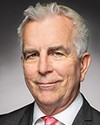Thank you very much, Mr. Chair and committee members.
I'm pleased to speak to you today on the topic of food security in the north, especially for Nunavik region, and on behalf of president and former senator Charlie Watt Sr.
Nunavik is an Arctic region that occupies the top third of the province of Quebec. We are north of the 55th parallel. Our region is bigger than the size of France. We have 15 communities on the shores of Hudson Bay, Hudson Strait and Ungava Bay. The total population is over 12,000. Think of it as an island. The only way to get there is by air year-round and by ship in the summer months.
Our remoteness greatly affects our food security. While southern Canada benefits from vast road and rail networks paid for by taxpayers, Inuit pay all taxes, yet the infrastructure gaps that exist in our airport facilities and the total lack of deep water ports contribute to driving up food prices and food wastage.
Food security exists when all human beings at all times have physical and economic access to sufficient, healthy and nutritious food enabling them to lead healthy, active lives. Food insecurity exists when an individual or a family does not have access to sufficient food. In the context of Nunavik, it is important to consider access to both traditional foods and healthy store-bought foods in improving food security.
The University of Laval has conducted studies comparing the cost of living in Nunavik and southern Quebec. These revealed that in 2011 groceries cost 81% more in Nunavik compared to Quebec City. “The Cost of Living in Nunavik” research report was the result of a 16-month intensive data collection and analysis between January 2015 and 2016, in which 450 randomly selected households in six Nunavik communities on the Hudson and Ungava coasts were selected for this project.
The survey revealed that low-income households spend a combined total of over 70% of their income on food and shelter, 43% on food and 27% on shelter. If you take a look at income, based on the 2016 census, median income for Inuit was just over $25,627, and for a non-Inuit it was $79,328. Inuit make three times less income, so if groceries cost 81% more and income is three times less than in the south, it all adds up to considerable food insecurity and additional social consequences to physical and mental health.
Programs such as nutrition north Canada help reduce the high cost of living, but they are not enough. Our region has created additional programs that we call the Nunavik cost-of-living reduction measures—administered by the KRG, the Kativik Regional Government, and negotiated with the help of Makivik—to go beyond the nutrition north program. There are six measures to help reduce cost of living: elders assistance; airfare reduction; country food community support program; household appliances and harvesting equipment program; food and other essentials program, which provides rebates of between 15% and 35% on the majority of food items purchased in Nunavik; and a gasoline program, with a discount of 40¢ on the litre on gas. The price of gas is set once a year in Nunavik. It comes by sealift. Right now a litre of gas costs $1.85. In Ottawa, on December 8, gas prices ranged from 90.9¢ at Costco to 94.9¢ at Canadian Tire.
Under the cost-of-living reduction program, the Government of Quebec committed to pay $115.8 million over the next six years, starting in 2019.
For us, however, food from the south is only one part of the picture when it comes to the food that we eat. The food that we hunt is just as important, if not more important, because it not only feeds us physically but feeds us culturally and spiritually as well. Inuit food security includes culture, health and wellness, and food sovereignty—our decision-making power and management over our food resources.
We are members of numerous wildlife committees. In addition, Makivik has owned and operated the Nunavik Research Centre, based in Kuujjuaq, for decades. We conduct our own research directly on country food that we eat, and control this information. That's part of what we consider our food security.
The new harvesters support grant was well received. Subsistence harvesting is vital to our food security. We need to underline, however, that at the time this program is being rolled out we are experiencing restrictions on polar bear, beluga and soon caribou harvesting. The Inuit population is growing and pressures on wildlife population are high. It's vital for us to be able to access wildlife. It's also important for communities to have the capacity to become fully involved in wildlife monitoring and management.
Let us talk about some of the projects that exist in our region. The Pirursiivik project in Inukjuak on the Hudson Bay, in collaboration with Makivik, the One Drop Foundation, the RBC Foundation and the Sirivik food centre, has created a year-round greenhouse focused on growing traditional plants and gardening.
The hydroponics container in Kuujjuaq—you may have seen The Growcer on CBC's Dragons' Den—is a shipping container, completely self-contained, designed to assist indigenous communities in remote regions, especially in the Arctic. This project provides fresh vegetables for us in Kuujjuaq. Also in Kuujjuaq, we have a soup kitchen, a food box program for elders and an on-the-land program.



